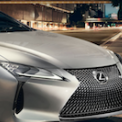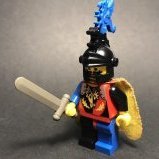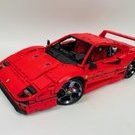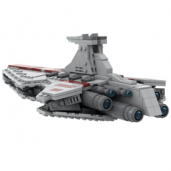Search the Community
Showing results for tags 'heavy'.
Found 18 results
-
Hi guys! At least I has finished my next MOC and want to introduced the finished model to all of you! Welcome my International Lonestar truck! It's dimensions are: - Lengh: 101 stud or 80 cm - Width: 31 studs or 25 cm without mirrors - High: 37 studs or 30 cm excluding antennas and exhaust pipes. It consists of more than 5000 Lego parts, including 9 motors. It has: - Great Charbel's 8 speed gearbox, modified by me to the 16 speed one by adding high/low gear to the main output. It has a special shifter. It's all RC. - Independant powerfull pneumatic brakes on each wheel. Inspired by Sheepo's Peterbilt. - Pneumatically controlled fifth wheel. - Independant suspencion on front and dependant one on the rear axles. - Suspended driver's and passenger's seats, doors with locks and shock absorbers. - Detalized interior. - Inline 6 cylinder engine like the real truck. Power functions is described at the picture below, I think this is more interesting than just to read. Also I include pneumatics sheme. Enjoy the pictures please, I hope some video will apear nowadays. Unfortunately, rear differentials can't cope with such a huge torgue and truck cant drive fast on the floor, sorry. Please visit my Bricksafe page for more photo. Building instructions are available here: https://rebrickable.com/mocs/MOC-9788/OleJka/international-lonestar-truck/#comments VIDEO AVAILABLE NOW!!
- 101 replies
-
- gearbox
- pneumatics
- (and 5 more)
-
REVIEW - 42052 - HEAVY LIFT HELICOPTER INTRODUCTION Helicopters, planes...basically everything airborne is +1 for me. The 9396 - Helicopter is one of my favorite models. I own three copies, which says it all. the news about a new helicopter made me very excited. The news about twin rotors made me even more excited. Although I must admit I was hoping for a Chinook style tandem rotor, instead of a double rotor where one is positioned on top of the other. This set does come with a Chinook style B-model, so maybe that will be worth building. One thing I immediately like better than the 9396 is the color scheme. I love the bright orange-white combination. This set seems to have a huge number of panels, which is not to everyone's liking. Let's find out what's going on underneath that smooth surface! Note: All images can be clicked for hi-res versions. SET INFORMATION Number: 42052 Title: Heavy Lift Helicopter Theme: Technic Released: 2016 Part Count: 1042 Box Weight: 1831 gr Box Dimensions: 57,0 cm x 37,3 cm x 8,0 cm Set Price (MSRP): € 119,99 Price per Part: € 0,115 Links: Brickset, Bricklink THE BOX The box is fairly big, which indicates a pretty big model. Unfortunately the box was damaged. Some cracks and dents, but luckily it wasn't ripped apart, like my Mercedes box. I'm not sure if TLG sends out the sets the same way when they sell via S&H, because I would be slightly disappointed to receive my sets like this. Update: I've seen more complaints about wrecked and/or damaged boxes, so there's room for improvement in the shipping department. The front of the box shows the helicopter lifting it's load. The model is 60 cm long and 53 cm wide. It also shows the contra-rotating rotors. As you can see an M-motor and battery box are included, so there are some powered functions. BACK The back of the box shows which functions are powered. We will deal with the functions later. It also shows the Chinook style B-model, which has motorised functions too. Looking at the front of the B-model I am not very tempted to build it. It looks like a flying guinea-pig CONTENT OF THE BOX The box contains: Sealed instruction booklet with stickers 6 Helicopter Blades 1 Sealed M-Motor 1 Battery Box 2 Soft Axles 10 Unnumbered Bags SEALED INSTRUCTIONS WITH STICKERS The stickers are sealed with the instruction booklet, like we are getting used to with bigger sets. I've said it before, but TLG deserves a big thumbs-up for this! The sticker sheet is still in perfect shape! HELICOPTER BLADES This set contains six of the Large Technic Rotor Blades, first released in the 9396 - Helicopter in 2012. PF BATTERY BOX AND M-MOTOR SOFT AXLES Two Soft Axles, or Flex Axles, are delivered unbagged. 19L? Who knows! More on these later BAGS Ten bags containing the rest of the, mostly white, parts. HIGHLIGHTED PARTS This chapter describes new and interesting parts. Not sure if it's a trend, but like the 24 Hours Race Car this set also has an abundance of panels. I've counted 51 of 'em (not counting the engine covers). It does have two new panels, introduced in most of the 1H 2016 sets. As from today this set officially contains the most Technic Panels. One more than the 42025 - Cargo Plane. 42052 - 51 panels 42025 - 50 panels 42039 - 47 panels BLUE 5x3 BENT PANELS These new Bent Panels seem to be very suited to make fenders/wheel arches and seats. AXLE AND PIN HOLE The axle counterpart of the Pin and Pin Hole. YELLOW 5L AXLE From what I can tell at the moment, the yellow 6L Axle is unique to this set. I made a mistake here. It's actually a yellow 5L axle instead of 6L. RED 6L AXLE Like the yellow 6L axle, the red 5L Axle seems to be unique to this set. This will obviously change over the course of time, but for now it's the only set containing them. I made a mistake here. It's actually a red 6L axle instead of 5L. 19L SOFT AXLES Finally, the black 19L Soft Axles! A lot of people will be glad to see these being used again. Only released in the 8450 - The Mission in 1999, this part has become very rare. DRUM TIPPER Of course these are no Cement Mixer Drum Tippers (60018 - Cement Mixer, 7990 - Cement Mixer). These are Helicopter Engine Covers, and quite good looking ones. They seem to be more versatile then you'd imagine, since they already appeared in 4 other sets. GREEN 3x11 PANEL Two green 3x11 Panels, not to be confused with bright green, used in the 42039. This is the same green as the 42008 - Service Truck from 2013. ORANGE PANELS A collection of 13 orange panels. WHITE PANELS A collection of 34 white panels. WHITE 5x11 TAPERED PANEL PLATE Introduced last year in the Fire Plane, this is a relatively new panel. 2x4 PERPENDICULAR BENT PIN CONNECTOR This 2x4 Perpendicular Bent Pin Connector was introduced in 2013 and it's one of those parts flying under the radar. You won't be needing this every day, but who knows when it might come in handy. PART LIST The set consists of 1042, shown below. THE BUILD Upon opening the booklet with building instructions, I noticed the color of the pages has slightly changed. The pages are lighter blue than we're used to. Probably to increase the contrast and make the difference between the darker colors better visible. This new color is used in every booklet of the new sets. The build setup is a bit different than we're used to. Usually you start by building one side, followed by adding things inside and finished by closing up the model. This time you start by building the fuselage, after which you continue with the gear box and rotors. ROTORS The image below shows the mechanism for the contra-rotating rotors. Actually I made a mistake here. I switched the two turntables. Luckily it didn't take me long to find out. At the top you can see an Axle Connector with Axle Hole which is connected to an axle going through the turntables. This axle is only connected to one of the turntables (obviously). The first set of rotors is connected to one of the turntables, while the other is connected to the axle going through the turntable. This is demonstrated in the video below. GEARBOX Here you can see the setup of the gearbox. A basic setup with a single layer of gears (more or less). You can see the 3L Driving Ring on both sides of the model, used to switch between the different functions. CARGO BAY DOORS I found the mechanism to open the bottom cargo bay doors to be very intriguing. Here you can see three stages of moving the H-Frame down. The video below demonstrates the gearbox and the mechanism for the cargo bay doors. This video shows the gearbox mounted on the fuselage, and the contra-rotating rotors. CARGO CONTAINER The cargo container wraps up the build. FINISHED MODEL Leaving the other building steps for you to discover, we skip right to the finished model. There's always a lot of debate about panels and closing a Technic model with them. I personally love a finished look with panels. Looking at the image below, I can only compliment the designer with his accomplishment. The helicopter looks fantastic! The design itself is fantastic and the color scheme is really spot on. This helicopter looks even better than the 9396 - Helicopter, which I will compare later in this review. The Drum Tipper parts used as engine covers is very well done. You would almost think they are designed to be used in this helicopter. SIDE REAR VIEW In this picture you can clearly see the rear cargo bay door/ramp and the landing gear. The tail rudders are operated manually, which is slightly disappointing. The solution in the 42025 - Cargo Plane was much better. The landing gear is pretty clever though. Very simple, but it works like a charm, using nothing more than gravity. SIDE VIEW The side view shows how well the helicopter has been designed. The panels align very well and the model is almost entirely closed. This is a matter of personal preference, but I absolutely love it. BOTTOM VIEW Yup, there it is...the battery box. You can also see the mechanism to operate the tail wing. I find this to be a weak spot of the model. The lever is positioned very close to the wing itself, which feels a bit useless. It would have been great to operate the wing with the orange Bionicle Tooth located near the tail gate. You can clearly see which panels are used for cargo bay doors. Two 3x11 panels are used as bottom cargo bay doors, and a 5x11 is used as the back cargo bay door (ramp). Both are operated by the Power Functions motor (see features and functions). FRONT VIEW REAR VIEW ADDITIONAL IMAGES Here are two additional images from different angles. PARTS LEFT It's interesting too see TLG provided an extra 19L Soft Axle. It appears to be used in the B-model, but it somehow feels like an added bonus, since this part is wanted by a lot of builders. The 6L"]http://alpha.brickli..."color":11}"]6L Rigid Hose[/url], which is also used in the B-model, is extra too. Since the instruction booklet tells us we are only supposed to get a single 19L Soft Axle, I am not sure whether it's used in the B-model (it looks that way though). FEATURES AND FUNCTIONS This set has the following features: Contra-rotating rotors (Power Functions) Opening bottom cargo bay doors (Power Functions) Opening rear cargo bay door/ramp (Power Functions) Operating the winch Operating tail wing (Manual) Operating tail rudders (Manual) Landing gear Castering nose wheel The following video demonstrated all of the functions/features. I have added an IR receiver and I am using a PF remote to operate the powered functions. As you can see all the functions work very smooth. The powered functions work pretty fast, so there's no waiting for ages before the cargo doors open up. The winch is the slowest of them all, but that makes sense. As you could read in the review, I don't really like the manual tail wind and rudder functions. I know a designer needs to make concessions, but wasn't it possible to operate the tail wing with the orange bionicle tooth. The castering nose wheel does work properly, and so does the landing gear. Both very simple, but they do their job. SUMMARY Like I said at the beginning of my review, I am fan of flying machines. And to be honest, I am an even bigger fan of helicopters than planes or jets. This might influence my judgement. I am also a big fan of white, orange and grey, so that's another plus. And I happen to like models finished with panels. Do you see where this is going?! I absolutely love this model. The 9396 - Helicopter was one of my favorite models, but I like this one even better. The closed design is something I like a lot, as long as the model is packing some functions too. Panels alone don't cut it. Well, this set has some cool features under those panels. The mechanism for the contra-rotating rotors is pretty nifty. So are the bottom cargo bay doors. The things I like the least is are the tail wing and tail rudders. The tail wing is operated manually, but it's a simple lever positioned very closely to the actual wing. And the rudders are operated by simply moving the rudders themselves. As with the Mercedes I am not a big fan of operating a model by using the switch on the battery box. It confuses me, and you can't easily reach it. I understand TLG can't throw in a remote and IR receiver each time they supply a PF motor, but it's probably one of the modifications most AFOLs will immediately apply. That being said, I absolutely recommend getting this fantastic model! SCORE Okay, so how do I grade this set? 9 DESIGN Absolutely magnificent. 8 BUILDING EXPERIENCE Great build with some clever techniques. 8 FEATURES Great functions, but rudder and tail controls need improvement. 8 PLAYABILITY Lots of things to operate, but would work better with a remote control. 9 PARTS Contains lots of new parts and loads of white panels. 9 VALUE FOR MONEY Worth every penny. Will buy another one. 8,5 ABSOLUTE EYECATCHER BONUS COMPARISON I will end this review with a comparison between the "new" and "old" helicopter. As you can see my 9396 has a yellow and black color scheme, instead of the original yellow and red, but it will give you a clear picture on how these two compare. More pictures can be found on my Flickr page. Thanks for reading and I hope you enjoyed it.
-
Hello everyone: I am glad to share this project, the mining excavator, based on Cat 6090. Phisycal Configuration: The Lego Cat6090 is a motorized digger on tracked wheels, 2 XL motors provided enough torque. On the track frame is placed the main structure, and a heavy duty turntable allows good rotations, without fricctions. The turntable is rotated by means of 1 XL motor. The main structure contains: the XL motor for turntable, the air compressor, 4 servos for pneumatic valves and the controller. The design is ultra compact in order to meet the requierement of size/scale. The tracked whell is ultra rigid structure, designed to resist extreme load. The air compressor has 4 XL motor and 2 pneumatic pumps, in order to provide a constant air flow and high pressure, both pumps are de-phased 180° in order to reduce vibrations. 4 PF-servos open/close 2 way air valves, to command all pneumatic actuators. The boom has 2 large pneumatic actuator. Due to heavy height of the boom, 4 spring supply extra force during the elevation. 2 large pneumatics actuators push/pull the arm, those actuators are placed below the arm. 2 large penumatics actuators dedicate to rotate the bucket. 1 medium pneumatic actuator, open/close the bucket. Electrical configuration: Three 18650 batteries provide an average of 11.1 V, the compressor are suplied with 11.1 V, and the servos, lights and turntable motor are suplied with 9V. A BMS (Battery Managment System) manages the charge and the discharge durgin the operation. The tracked frame is steering by the use of 11.1 V, and as well is manage by the use of a BMS. On Board System (OBS): The name given to the controller. There are two systems, one for the main structure, and the secund is used to move the tracked well. The main controller, is a server TCP/IP protocol. The controller has a ESP8266 microcontroller with a TCP/IP stack, this controller is able to be programmed in arduino languaje (also micropython) - Teh ESP8266 is used as a sever, Motor driver: used to control the compressor The 4 PF servos are controlled by means of digital outputs, and the lights. ld293d, this is a H-bridge used to control the turntable motor. The second controller, is a ESP8266 as a client, and controls the speed of the tracks. Also, it has a BMS in order to regulates the charges/discharge of the batteries Accessories: 1) Josyticks: Two joysticks, with 4 dof (degrees of freedom) each of one plus a on/off button, are connected to the server module. 2) App: An application developmented under Android studio is used to visualizate the air pressure and electrical current, this app is WIP (work in progress). Conectivity: The comunication used is socket TCP/IP- Main features: maximun pressure reached: 52 psi (358 Kpa) Voltage bus: 11.1 V Compressor electrical consuption: 23 W Weight: 6 kg Length: 30 cm width: 20 cm height: 30 cm Here some pictures, during the construction and commissioning Note: my apologies for my primitive english
-

[MOC] Heavy Duty Skid-steer Loader
JLiu15 posted a topic in LEGO Technic, Mindstorms, Model Team and Scale Modeling
Experimental MOC combining Mindstorms Robot Inventor and Control+. Features drive, backing alarm, arm elevation, bucket tilt, and a pallet fork alternate attachment with manually adjustable fork width. Functions/features: Drive (4x medium angular motors; 1 per wheel) Arm elevation (C+ L motor) Bucket tilt (C+ L motor) Manually adjustable fork width (on pallet fork attachment) Backing alarm Ever since I had heard that the new Mindstorms Robot Inventor is cross-compatible with Control+, I made a goal of creating a MOC combining them. A skid-steer loader seemed like a good subject to start for me - I wanted the drive to be as direct as possible, without connecting the wheels on one side with gears to a single motor. This meant 4 motors for the drive and 2 motors for each of the arm functions - perfect for the 6 ports on the Robot Inventor hub. The building process started with a base for the model - 4 medium angular motors each connected to a single wheel via a planetary hub. The motors were sandwiched between 2 11x15 Technic frames, creating a robust structure. The Robot Inventor hub is placed behind this part, and the C+ L motors for the arm functions are located above the drive motors. The chassis was kept as flat as possible with everything kept low to lower the center of gravity. Just in front of the Robot Inventor hub are two gear trains that transfer drive to the arm elevation and bucket tilt functions. Thanks to the use of planetary hubs, the model had plenty of torque and is able to climb some steep slopes without any issues, as shown in the video. Aesthetics wise, the model has a simple yellow/black color scheme. My original inspiration for this model was the CASE SV340, so the color scheme had some resemblance to that. Building the bodywork was quite discouraging at first due to it feeling like a building a box on wheels, but the model's looks really came together as the arms and rear body panels were installed. I also used plates and tiles to cover up bare pin holes and make the model look more finished, especially on the roof but also in other areas like the front windshield pillars and the top of the arms. Additionally, the model includes a handful of new 2021 panels, such as the small 3L curved panel and the 3x7 flat panel. As for accessing the Robot Inventor hub, there are 2 discreet switches in the bottom rear of the model that press the power and Bluetooth buttons on the hub. As everything is done from my iPad after powering it on and connecting it via Bluetooth, I don't have to look at the screen or press the left/right buttons. The status sounds from the hub allow me to know if the hub is powered on, connected, or powered off. As for controlling the model, I created a simple control profile in the Robot Inventor app using its code blocks. Two sliders control drive, and the arm functions are controlled using buttons. Additionally, a backing alarm sounds when driving in reverse. This feature is only controlled by the left slider, as I found that controlling it with both will essentially cause two backing alarms to play over each other. One issue I had is that the drive motors often don't start all at once - there'd be a noticeable delay in one or more of the motors. The C+ motors for the arm functions, however, work fine. I'm not sure what causes this, but this will definitely be something to consider for my next Robot Inventor/C+ hybrid MOC. Overall, I'm decently satisfied with this MOC. It was an interesting experiment in combining Robot Inventor and C+ that largely went according to plan. As someone who builds Technic MOCs, the new Robot Inventor hub is far better than the EV3 brick - it's got much better form factor (it's even a stud lower than the C+ hub), uses rechargeable batteries and is therefore much lighter, and has 6 ports that aren't restricted to motors or sensors. The only downsides IMO are the color (as teal doesn't blend well with most colors in Lego Technic) and the bright screen, but that can be easily covered up as I've done here. I definitely have plans for more Robot Inventor/C+ hybrids in the future, whether that be a Robot Inventor hub MOC with C+ motors or a C+ hub MOC with Robot Inventor motors. Photos: Video: -

[WIP] Heavy Duty Skid-steer Loader
JLiu15 posted a topic in LEGO Technic, Mindstorms, Model Team and Scale Modeling
Hey guys, here's a new MOC I'm working on. This MOC will be an experiment in combining the new Mindstorms with Control+ to control 6 motors with a single hub. It will be powered and controlled by the new Mindstorms hub, with 4 angular motors for drive (1 per wheel) and Control+ motors for elevation and tilting. With the new Mindstorms having much better form factor than EV3, I anticipate it being much easier to use in my MOCs than EV3. The loader is inspired by the CASE SV340 skid-steer loader. However, some parts of that vehicle, especially the rounded section of the arms towards the rear, will be difficult to model with Lego pieces, so I won't model this after any specific skid-steer loader. So far, I have the chassis built. It's a compact chassis made of 4 angular motors sandwiched between two 11x15 frames. The wheels are driven through planetary hubs, giving it lots of torque. This gives me a good starting point to attach other elements, such as the arm mechanisms and the Mindstorms hub. This will definitely be an interesting build. When I learned that the new Mindstorms is cross-compatible with C+ thanks to both being in the Powered Up ecosystem, I knew I just had to make a MOC combining them. If all goes well, I'll definitely be experimenting more with the new Mindstorms in the future. If you have any suggestions for me, please let me know. Photos: -

[MOD/MOC] Lego City Mars Exploration - Heavy Mobile Lab
Horlack Bricks posted a topic in LEGO Sci-Fi
[MOD/MOC] Lego City Mars Exploration - Heavy Mobile Lab Built based on 2x 60225 Rover Testing Drive, 2x 60227 Lunar Space Station, 60229 Rocket Assembly & Transport on theme : Lego City Mars Exploration - Rover - Drone - 2 articulated arms: grippers and drill - Radar antenna - Various tools - Spacesuits / airtanks - Scientific analysis equipment - Microscope - 2 retractable berths - Cockpits NCS - Heavy Mobile Lab by Horlack, on Flickr NCS - Heavy Mobile Lab by Horlack, on Flickr NCS - Heavy Mobile Lab by Horlack, on Flickr ============================================ -

[MOC] Kalmar DCG180-330 Heavy Forklift
JLiu15 posted a topic in LEGO Technic, Mindstorms, Model Team and Scale Modeling
Model of a Kalmar heavy forklift controlled using SBrick. Features drive, steering, fork elevation, pneumatic mast tilt, kissing forks, tilting cab, 6-cylinder engine, and lights. Functions/features: Drive Steering Fork elevation Mast tilt (pneumatic) Kissing forks (manual) Tilting cab 6-cylinder engine Lights It's been a while since I created a MOC featuring pneumatics, and even longer since I created one with remote-controlled pneumatics. My last MOC with fully remote-controlled pneumatics was from 2015, and that was before I had an SBrick. Ever since I obtained an SBrick I had made two MOCs with remote-controlled pneumatics - a front loader in 2016 and a Volvo EC350E excavator in 2019. However, both projects were cancelled before I finished them. I realized the mast tilting function on a forklift would be a good choice for pneumatics, especially the 7L cylinders. I originally just wanted to make a generic heavy forklift, but when I came across Kalmar's heavy forklifts I was really intrigued by their design so I decided to make the DCG180-330 by Kalmar. My model maximizes functionality while minimizing the amount of moving parts. Most functions have their motors connected directly to their inputs, thus minimizing moving parts and optimizing chassis space. The drive motor is placed directly behind the differential, and gear reduction is done via portal hubs placed horizontally. The servo motor for steering is placed vertically in the chassis, connected directly to the steering linkage without a rack-and-pinion mechanism. This allowed for a large steering lock which is commonplace among forklifts, but this also meant that the chassis around the axle has to be thin so the wheels don't bump into them - in fact, the chassis is only 3 studs wide in the rear but is reinforced well nevertheless. I limited the servo's range of movement in the SBrick profile designer as the steering input can only turn about 45 degrees each way. Even then I still had to add towballs as limiters to the steering mechanism to ensure the wheels don't rub against the rear body panel when turning. In the end, I wish the wheels could steer a little tighter, but the end result is impressive nonetheless. The mast is built with a PF L motor near the top, which drives a worm gear mechanism controlling fork elevation. The section that lifts up is essentially a frame with two sets of racks that contain the fork module sliding freely within it. A single rope pulls the fork up, and the range of movement is pretty impressive. The fork module contains two manually controlled linear actuators that allow the forks to move closer to each other - "kissing forks", as the PDF for the real-life counterpart calls it. The pneumatic system for the mast tilt function is comprised of a PF L motor driving the compressor and a PF M motor controlling the valve. The L motor for the compressor is geared up slightly to allow rapid pumping, and the valve mechanism is placed at the very front of the model to minimize the length of the hoses connecting the valve to the cylinders. Other features include a tilting cab, a 6-cylinder engine with mini pistons below the cab, and lights connected directly to the 8878 battery so the speed dial on it can be used to control their brightness. The 6-cylinder engine is accurate, as one of the engine options on the real Kalmar DCG180-330 is a Cummins B6.7. The fake engine is connected directly to the drivetrain and makes a pretty cool noise while driving. The functions overall worked pretty well - it had decent driving speed, a really good turning radius, the fork elevation had sufficient torque without being painfully slow and the pneumatic mast tilt had good precision. There were some issues - such as the fork elevation mechanism skipping at the racks when under load and the pneumatics not being able to tilt the mast back when the fork is fully raised and the mast is fully tilted in the forward direction. The fork mechanism also lacked a clutch, so it was really important to stop the motor precisely at the moment the fork reaches the bottom to prevent it from stalling. Still, given how well the functions worked overall and how realistic and detailed the bodywork is, I feel like this MOC was a great success. Video: Photos: -

[WIP] Kalmar DCG180-330 Heavy Forklift
JLiu15 posted a topic in LEGO Technic, Mindstorms, Model Team and Scale Modeling
Hey guys, here's a new project I'm starting. It is a model of a Kalmar forklift. It will be controlled by SBrick, and it will feature drive, steering, pneumatically tilted mast and lifting fork. The wheels will be Unimog wheels (94.3x38 tires). https://www.kalmarusa.com/4ae438/globalassets/equipment/forklift-trucks/kalmar-forklifts-1852-ton-capacity/kalmar-dcg180-330-forklift-brochure-en-us.pdf So far I have the front axle and the rear portion of the chassis completed. The front axle is driven and is very compact - most of the gear reduction is done in the portal hubs so the drive motor is attached directly behind the frame holding the differential. As for the rear portion, it contains the steered rear axle. Note that the longitudinal beam supporting the chassis is only 3 studs wide directly below the rear axle - the steering lock is very large to ensure a minimal turning radius, and this avoids the wheels from rubbing the chassis when turning while also keeping the chassis sufficiently robust. I also have the compressor (driven by a PF L motor) and the SBrick installed. Note the vertical placement of the motors - I'm trying to make the model as compact as possible, and this avoids using too much longitudinal space. I was concerned that the servo motor might not have enough torque this way as it's driving the steering linkages directly rather than with rack and pinion (it will be limited to 45 degrees of rotation in the SBrick profile designer), but I've seen MOCs that use the servo like this and they work fine. If you have any suggestions for me, please let me know. Photos: -
The Dreadnaught Class Heavy Cruiser is a Star Wars warship well known from the lost Katana Fleet of the Thrawn Trilogy. At 600 meters, it was roughly half the length of a Venator and could be configured with varying combinations of turbolasers, point defense cannons, and missiles. Most of these would be located in the hull "blisters" similar to Mon Calamari ships. I was recently acquainted with the cruiser as I'm reading through the Thrawn Trilogy (Half way through the second book at the moment). Not the most sophisticated-looking ship, but a fun one to design nonetheless. As usual, it's designed to 1:2600 scale. Some additional views in the spoiler below...
-

[REVIEW] 42079 - Heavy Duty Forklift
Jim posted a topic in LEGO Technic, Mindstorms, Model Team and Scale Modeling
REVIEW - 42079 - HEAVY DUTY FORKLIFT INTRODUCTION With 592 parts the smallest of the 2H 2018 sets. Of course, less parts doesn't mean a lesser model. It looks interesting enough and it has a promising B-model. The previous forklift (not counting the mini 8290) was the 8416 Fork-Lift from 2005, the year I got out of my dark ages. Needless to say this is a while ago. Like cranes, lots of people tend to like forklifts. Probably like those people, I am hoping that TLG will some day release a big forklift flagship, full RC, so you can fully control it like the 8043 - Motorized Excavator. But I digress. Let's see what this Heavy Duty Forklift has to offer. If you see this icon, you can click the image on the left or right side of the image, to cycle through alternative images. PICTURES Pictures can be clicked to view hi-res versions. More pictures can be found in my Flickr album. DISCLAIMER This set has been provided by the CEE Team of TLG. It's not my goal to promote this set. It's my goal to give you an honest opinion about it. Therefore, the opinion in this review is my own and is in no way linked to TLG. SET INFORMATION Number: 42079 Title: Forklift Truck Theme: Technic Released: 2018 Part Count: 592 Box Weight: 1,24 kg Box Dimensions: 37,7 cm x 25,7 cm x 9,0 cm Set Price (MSRP): £ / $ 69,99 / € 49,99 Price per Part: £ / $ 0.118 / € Links: Brickset, Bricklink THE BOX Apparently the size isn't important, or impressive, enough to mention on the front of the box. It only shows the Forklift transporting a drum with dangerous content. The picture in the top right indicates that the carriage can go up and down. That's great, being a forklift and all. BACKSIDE At first glance, this doesn't seem to be a very special set, but the backside reveals a very good looking B-model. This alternate model could almost have appeared on the front of the box. Other than that, it has an interesting color scheme, some nice dark blue panels. Color me interested! CONTENTS OF THE BOX This set contains: 2x Instruction booklet 1x Sticker sheet 4x Tire 6x Unnumbered bag INSTRUCTION BOOKLETS We have seen this before, but I was still pleased with getting the second booklet out of the box. STICKER SHEET Nothing out of the ordinary. Just a couple of stickers to provide some details for the bodywork, and of course the DANGER sign for the drum. TIRES Probably some of the most commonly owned tires by AFOLs, but we haven't seen these last year (2017). Last set to use these tires is the 42049 - Mine Loader from 2016. BAGS The set contains six numbered bags. HIGHLIGHTED PARTS Unfortunately, this set doesn't contain any of the new parts. Or any interesting parts for that matter. I have highlighted the following parts as the most interesting of this set. GEAR RACK AND HOUSING This Gear Rack Housing and Gear Rack can be found in six other Technic sets. The light bluish grey housing is only available in two sets though. DARK BLUE PANELS If you want these dark blue panels you are limited to just a couple of sets. And I probably don't need to tell you that two of these sets are pretty expensive. PART LIST Here's the complete part list showing you 592 parts. THE BUILD Early in the build, the chassis already contains a lot of the functional parts. The front wheels with differential, connected to the axle and gears for the fake engine. Two universal joints (U-joints) are used to connect the axle in the mast. In the picture on the right you can see the steering mechanism. Forklifts usually steer with the rear wheels, which is also the case for this vehicle. This profile view shows part of the cabin taking shape, and the 2-cylinder fake engine has been placed. Behind the driver's seat is an axle going down in the chassis. It's connected to the axle leading to the mast of the forklift. BODYWORK The bodywork gives the forklift a finished look. I like the shape and color scheme of it. The light on the top of the vehicle is not the Hand of God steering. In this case, it's the Hand of God lifting hehe. CARRIAGE The carriage is lifted using a Short Worm Screw Gear. The lifting height of the forklift is 16 studs. Thanks to M_Longer for measuring it. I forgot to do that and I currently have the B-model assembled. Always build the B-model first if you are writing a review and you will be covering both models. In case you are wondering how this is measured, here's the exact quote: "I have put a 16L link under and it fit perfectly ;)" LEFTOVER PARTS The usual selection of small parts. COMPLETED MODEL The completed model has an exhaust which provides Hand of God steering. I do like the position of the steering mechanism, but I don't like the fact it is connected directly to the gear rack. This not only results in inverted steering, but also in rather direct steering. I would have liked to see some gear reduction and reversal of direction. I can understand there is little place for an intricate system, but I still think it was feasible. This being a minor gripe, I do like this model a lot. I love its looks and its simplicity (in a good way). I had this model standing on the table and my five year old nephew immediately started playing with it. I only had to explain the tilting mechanism, which is located at both sides of the cabin, but besides that, he quickly started turning the knobs. LIFTING MECHANISM Click on the image below to show the lifting mechanism. REAR The rear of the vehicle does show some unused space. This gives me reason to believe a better steering mechanism could have been concocted. I do like the looks of the rear though. The solution with the two small panels is nicely done. From a slightly different angle the forklift does look those big boys driving around in harbor areas. Another picture from the rear. I can only conclude that it's a good looking model. B-MODEL Since the instructions for the B-model are included in the set, it's only logical to include it in the review. Lucky for me, my lovely partner @Kitty was willing to spend some time building this alternate model. She is not really into Technic, but she is willing to help me out every now and then. Usually, she is taking sets apart, but occasionally she assists building them, like now. Unlike the forklift, the fake engine is placed at the front of the chassis. So is the steering mechanism. Here's a side view with the crane attached. There is no mechanism to extend the boom. You simply need to operate it by hand. The finished model is actually very good looking. And it has the basic functions you would expect from a tow truck, steering, working fake engine and a crane/boom. Granted, a mechanism to operate the boom is absent, but this being the B-model, I can live with it. Shooting pictures for models with some sort of hook is always a challenge. The hook never hangs as you would like and it takes a couple of minutes for the hook to completely hang still . After putting the model on the table you wait...or go about some other business. And a picture from the rear. This is one of those sets which is actually 2-in-1, having a proper alternate model AND instructions to build it out of the box. Below is a picture of the left over parts. SUMMARY For a Heavy Lift Forklift it feels a bit too compact. Like I said in the introduction of this review, it would be cool to have a Heavy Lift Forlift, which is actually massive, like the real machine. Of course, this has nothing to do with the quality of this model. Lifting the forks/carriage is done via the beacon light on the top of the model. Tilting the mast is done via the levers on both sides of the cabin. Both functions work properly. Steering is done via the exhaust at the rear of the model. Steering is very direct and above all, it's inverted. This could have been done differently. At this price point, getting basically two proper models is great value. All in all I really do like this set. Nothing extraordinary, but if will definitely make for a nice gift. Downside for AFOLs is that most of us will be able to make this with our own inventory, since it doesn't contain any new parts. PROS It's affordable. Two very nice models. Functions work properly (steering can be improved though). CONS No new parts have been used. Steering is inversed (minor gripe). SCORE How do I rate this set? 8 DESIGN Two very good looking models, especially for a set this size. 7 BUILDING EXPERIENCE Nothing really special, as expected. But still fun to build. 8 FEATURES Properly working manual features. 8 PLAYABILITY Lots of playability. 7 PARTS No new parts were used. Other than that is an okay selection with some nice dark blue pieces. 9 VALUE FOR MONEY The cool B-model adds a lot of value to this, already great, set. 7,8 FOR LIFTING AND TOWING FINAL WORDS @M_Longer has created an LXF file which he has share in this topic. And @JunkstyleGio has created two wonderful renders. Thanks you for reading this review. All pictures can be found here. -

42079 - Heavy Duty Forklift
Jim posted a topic in LEGO Technic, Mindstorms, Model Team and Scale Modeling
-

[MOC] Heavy Duty Forklift RC
Dalafik posted a topic in LEGO Technic, Mindstorms, Model Team and Scale Modeling
UPDATE: Instructions & parts list are available at Rebrickable. Three years ago I made this forklift as a an alternative of the 42009 set. Ever since then I wanted to make a proper RC version of it. So here it is. Overall it is a better rendition of a generic heavy forklift. It is narrower, shorter and better scaled than its predecessor. You may criticize me for the lack of slopes and curves, but that's my building style - I always prefer sturdiness over beauty. There are 4 motorized classic functions: Movement (L-motor) Steering (servo) Mast extension (L-motor) Mast tilting (S-motor) Manual functions include sliding blades and openable doors. Here is an extremely short video demonstrating the model at work. Sadly, lack of gradual control over the motor's power makes it hard to move smoothly. So, what is your verdict? -

Need Help Making Heavy AWD SUV Move Better
StudRobotics posted a topic in LEGO Technic, Mindstorms, Model Team and Scale Modeling
I'm back with one last issue in my GX EV3 build. I just got done finishing the doors, side panels, rear trunk door, hood, and some part of the roof. But the vehicle was so heavy that when I drove it around, it kept on doing the same thing. The diffs were clicking and the car had very much difficulty moving. Here is a picture of the bottom of the vehicle. Most of the clicking seems to be coming from the rear diff when I move the wheels by hand. I can either do two things. 1. Reinforce the rear diff somehow. 2. Improve it's off-road performance and stop the clicking somewhat by replacing the diffs with knob gears. But this will come at the cost of independent moving between the wheels. What should I do? Please give me the best response you can so the clicking will stop and I could finally take this AWD machine through some rough terrain like a real SUV. I really appreciate any advice. -
Recently I've been building all of the tie variants. After a long series of delays( bad design, wrong proportions, narrow body and the occasional missing parts), the entire collection is almost ready! Some are undergoing remodeling and will be ready soon! Currently, I don't have enough parts and they are only in LDD models. these below are the canon tie variants the tie fighter the tie interceptor the tie bomber the bomb bay the tie defender tie boarding shuttle(with landing gear) coming up are most of the legends tie variants.( Still building some!) the tie VIP shuttle tie aggressor tie avenger tie sentinel coming soon tie oppressor tie interdictor tie heavy bomber royal guard tie interceptor and here are the tie experimentals tie experimental M1 tie experimental M2 tie experimental M3 coming soon tie experimental M4 coming soon tie experimental M5 And that's all of them! Let me know if i missed any tie model in the imperial navy(not the Astragon navy) below. Hope you all will appreciate the work I've done here! (Although I used the first order tie fighter for the M2 and tie fighter with minor edits and as the cockpit base for the fighters without hyperdrives) For the mini fighters(compatible with 75106 assault carrier), I will post them soon!
-

[TC10] Pneumatic 'Nemesis'
Aris posted a topic in LEGO Technic, Mindstorms, Model Team and Scale Modeling
Dear all, For the pneumatic contest, I've built a huge robot called ''Nemesis''(from the ancient greek goddess) and I would like to share it with you. Nemesis has 22 pneumatic functions operated by a double compressor. All pneumatic valves are operated only manually according to the competition. Has a weight of 8kg and consists of 8000 lego technic bricks. Total air cylinders : 26 large 11 mini The compressor uses 2 large pneumatic pumps operated by a PF XL motor. The maximum pressure that can be reached by this pneumatic system is 28 psi with fresh batteries. Due to more than 30 pneumatic ''T-air pieces''pressure cannot reach a higher level because there is a huge drag and the XL motor has no power to rotate more. The length of pneumatic tubes are between 0.5 and 1.5 meters long. Due to the large hoses, large air storage is needed because there is a lot of air loss in the system. The air of the whole system is stored inside 2 lego air tanks (although the system needed far more) : The compressor has an auto-pneumatic switch using a large cylinder, which turns the air engine off when the pressure reaches 24 psi. A manometer is used for showing the air pressure at any time. Functions : Nemesis has 2 arms. The bigger front arm has 15 pneumatic functions and the small back arm has 5 pneumatic functions. The small back arm has the following movements : a) small gripper b) elbow1 c) elbow2 d) shoulder e) shoulder rotation The huge front arm has the following movements : a) large gripper, operating 10 fingers independently having 2 mini cylinders each b) wrist, operating 2 functions (up-down and turning) c) elbow d) shoulder e) shoulder turning Besides, the robot has 2 more pneumatic functions : 1) Face movement 2) A third gripper which is mostly for fun (e.g. for scaring house cats) Here is the video of the project : Thanks for watching Good luck to everyone! -

[MOC] XL Lego Supercar with Motorized Suicide Lambo Doors
Lox Lego posted a topic in LEGO Technic, Mindstorms, Model Team and Scale Modeling
Due to the XL size of this car the placement of larger panels across the width of the car was possible. This really gave the vehicle a unique styling. I was able to use the large red panels for the interior and the black panels at the bottom rear of the car. Inside are 2 XL motors for drive, servo for steering, and 1 m-motor for the motorized suicide doors. The weight was so excessive on the shocks I had to put an extra strong shock on each axle bringing the total to 12 shocks. Still, the frame barely misses the ground. Framework was completed 100% from scratch, with a fake inline 6 engine. Check it out! Brickshelf link: http://www.brickshel...ry.cgi?f=563502 https://www.flickr.com/gp/139930963@N04/0dHU77 -
A brand new custom lego Freight Train made in LDD. I can't seem to upload the screenshots here. Check out the screenshots on MOCpages: [link removed: self promotion]
-
^ CLICK THE IMAGE ABOVE TO VIEW THE GALLERY ON FLICKR. ^ Built in February 2013. Feedback is appreciated. (Yes, the name is irrelevant.)
- 11 replies
-
- Bionicle MOC
- heavy
-
(and 2 more)
Tagged with:




